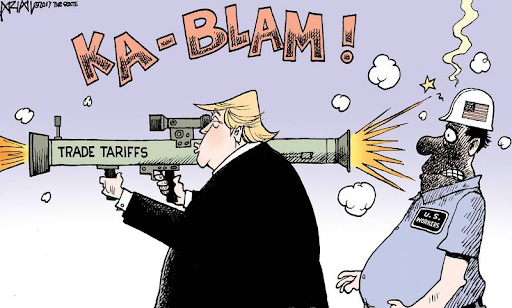Donald Trump seems to be in love with the word “tariffs” – only rivaled by his marriage with his significant other, Elon Musk. To understand the next big thing in the MAGA movement, we need to figure out the one question: Why tariffs?
Negotiation Leverage:
Trump’s main reason for targeting other countries with his tariffs is for negotiation purposes. In fact, looking towards his deal with Canada and Mexico, where they promised troops instead of getting hit with immense tariffs, it’s clear how Trump is trying to use tariffs to “extract political concessions from trading partners.” [1]
This negotiation stance, however, has only seen short-term benefits. Canadian markets and consumers are boycotting American goods as a form of resistance, with signs being purposely placed on them to avoid. Politically, Trump is also facing backlash with newly elected prime minister, Mark Carney, who stated that “Canada’s old relationship with the US is over.” This has threatened one of the United States’ closest political allies to consider changing their historically important and economically beneficial trade relationship with the US, accounting for 3.6 billion daily. [2]
Reducing Trade Deficits:
Trump’s policy objectives have significantly focused on reducing the trade deficit the US has with other countries. By putting in tariffs, US consumers are more likely to purchase US goods with an increase in prices for internationally sourced goods. This not only enables the US to be more self-reliant but also helps decrease the continuous deficit we have with other countries [3]. Although it seems Trump’s tariff style in cutting down internationally sourced goods is a huge shift for a consumer base that significantly relies on other countries for goods.
In fact, one of the sectors Trump has significantly targeted for this, manufacturing, serves as a prime example of how this method is hard to implement. The United States heavily relies on international actors for manufacturing, often due to its cheaper prices. With Trump implementing tariffs, it actually has had an adverse effect. Due to American manufacturing not being large enough to handle the capability of what American businesses and consumers demand, many still rely on external actors for manufacturing. This has led to higher prices for the same manufacturing, and as businesses pass the tax on to consumers, it could potentially lead to heightened inflation.[4]
Additional Revenue:
Donald Trump has vehemently focused on trying to tackle the federal government’s huge budget deficit, approximately 1.7 trillion at the time of writing. His plan not only includes the implementation of DOGE, The Department of Governmental Efficiency, but also using tariffs as a means to generate revenue [5]. Trump believes that by implementing tariffs, he will collect this “revenue” as a form of investment back into the United States budget; but in reality, this is only going to lead to a decrease in international trade cooperation for the United States.
Even though these high tariffs can generate some revenue, countries like Brazil, China, Russia, and Malaysia are trying to lean away from American trade. This not only creates issues in finding goods for US businesses and consumers in the future, but also could create price increases and shortages in the long term [6]. By countries trying to move their trade away from the United States, these tariffs could create permanent channels and networks of goods excluding the United States, severely hurting its global dominance economically and politically.
National Protection:
Natural resources are extremely important for the basis of many American sectors, although we rely heavily on international trade to find these resources in the first place. For example, Chinese mineral refineries single-handedly power many of the important technologies we use today. Along with that, our biggest importer of aluminum is Canada, making up 40% of all the aluminum we get. This continued dependence on other countries for the very foundation of many economic aspects also puts us in dire situations. For example, when China put a block on all semiconductor minerals to the United States, it described the horrifying effects China could have with other minerals that the US desperately needs [7]. Although Donald Trump’s ways of tariffs, while helping reduce some dependence long term, also puts the United States in a bad position currently. After Donald Trump introduced many Chinese tariffs, China retaliated by halting some lithium exports to the United States [8]. This helps describe how the tariff agenda, while it may help reduce reliance, is such a huge shift (compared to other administrations that have been slowly reducing reliance) that it causes tension to rapidly expand (threatening what the US did NOT want threatened in the first place).
While Donald Trump’s tariff policy may be a stronger force of the MAGA movement, it comes with risks and pitfalls that the Trump administration will have to maneuver to prevent the deterioration of the United States on a global level.
[1]-https://www.wsj.com/economy/trade/what-to-know-about-trumps-latest-tariff-policy-moves-8d9f8b37
[2]- https://thehill.com/policy/international/5185455-canadian-leader-mark-carney/
[3]- https://apnews.com/article/trump-reciprocal-tariffs-trade-4112c661b1b82a2663a9eb0ecd6bd537
[5]- https://www.nytimes.com/2025/03/27/business/trump-debt-tax-us.html

